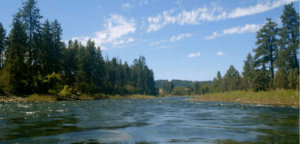River Revival in Spokane
By: Spokane Riverkeeper
Decades after their banning, Spokane faces up to the persistent peril of PCBs.
By Bart Mihailovich, Spokane Riverkeeper

PCBs, or polychlorinated biphenyls, are so famous – or infamous – that they’re known in environmental circles as a “legacy pollutant.” And one of the many U. S. waterbodies where they have left their mark is Washington State’s lovely Spokane River.
Legacy pollutants are chemicals, most often used or produced by industrial facilities, that remain in the environment long after being introduced. Once considered a miracle chemical, PCBs were manufactured in the United States from 1929 until they were banned in 1979. They were used in hundreds of industrial and commercial applications, including as dielectric (insulating) and coolant fluids in transformers, capacitors, electric motors and other electrical devices. PCBs entered the environment during their manufacture and use and also frequently leaked or were released from electrical equipment. They became a fiendish toxic hazard because, once in the environment, they do not readily break down and may cycle between air, water and soil for many years. They remain one of the largest obstacles to PCBS clean water – and to restoring the health of the Spokane River watershed.
On the Spokane River, PCB contamination continued to flow from the city’s antiquated stormwater-sewer system long after the banning, although this was discovered only in recent years. But thanks to the Clean Water Act, the Spokane region is on a promising path to solving this problem. Here’s how we got there.
In December of 2009, Spokane Riverkeeper filed a 60-day “notice of violation” with the City of Spokane as a precedent to a federal citizen-enforcement lawsuit to enforce, under the Clean Water Act, a dramatic reduction in these illegal discharges. The notice made clear that City of Spokane officials had known about illegal PCB discharges from city outfalls since 2004 but had repeatedly failed to report or take meaningful and effective steps to stop them. The city had violated both the Clean Water Act and the state’s municipal-stormwater permit for Spokane.
A leading actor in the case was the late Mike Chappell, director of Gonzaga University’s Environmental Law Clinic, who was co-counsel with Riverkeeper attorney Rick Eichstaedt.
“The citizen-enforcement provisions of the Clean Water Act exist for just these types of situations,” Mike would state repeatedly.
In April 2011, a settlement was reached, which, to the best of anyone’s knowledge, was the largest SpokaneRiver-related environmental settlement in the region’s history. The agreement called for combined-sewer-overflow fixes, enhanced education and outreach, and funds for restoration projects in the area. But maybe more important than the dollars or the significance of the settlement was the region-wide discussion on PCBs that followed – leading to a well-organized and very sophisticated collective effort to identify PCB sources in the Spokane River basin and address them in various ways, from permit-compliance to clean-up to source-control.
It is our belief that without the Clean Water Act as a vehicle to get us to this place, and without the amicable settlement, PCBs would still be largely unaddressed, and a major source of water pollution in the Spokane River would be further down the “to-do” list. Instead, the Spokane River is cleaner today than it was in 2009.
This process has underscored the critical importance of laws such as the Clean Water Act, Safe Drinking Water Act and Endangered Species Act, as well as many state regulations. It has also demonstrated that the agencies in charge of enforcing these laws must be supported and reinvigorated if they are to do their jobs properly. This is a big push, and it’s going to require us to be not just on the defensive, but the offensive as well.
Over the past 40 years, the Clean Water Act has been a path-breaking statute for tackling America’s water problems. But if we are to solve this country’s, and the world’s, looming water crisis, then we must make sure that is an even more powerful instrument over the next 40 years. Pat Mulroy, general manager of the Southern Nevada Water Authority, and one of the country’s most progressive water managers, has famously said, ““ If you want to really think outside the box, and really solve our water problems, we need to talk about solutions we’ve never had the courage to talk about before.” Now is the time to show that courage.